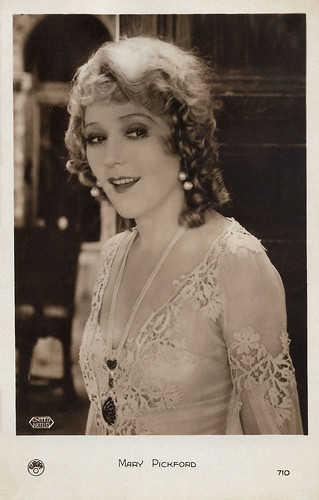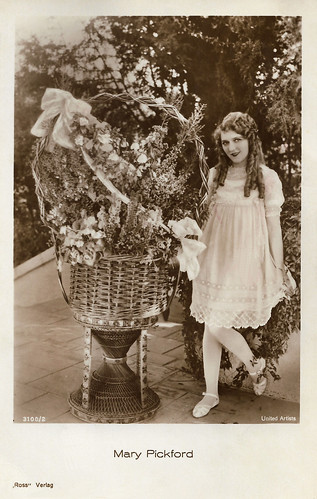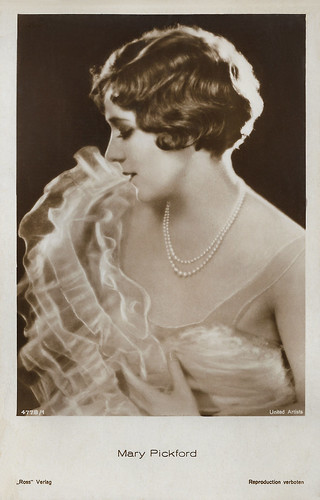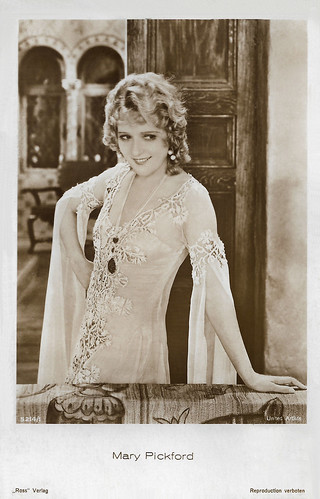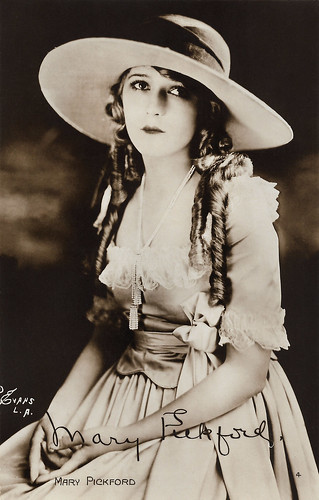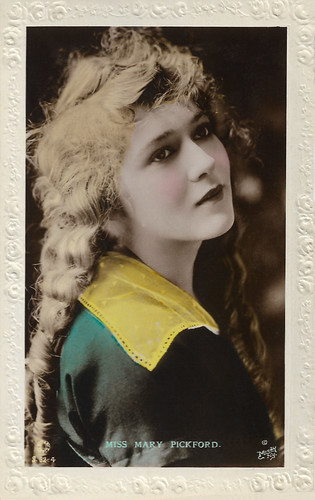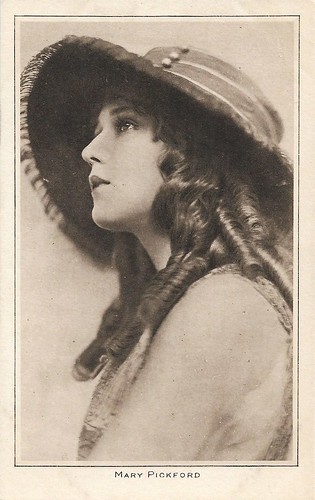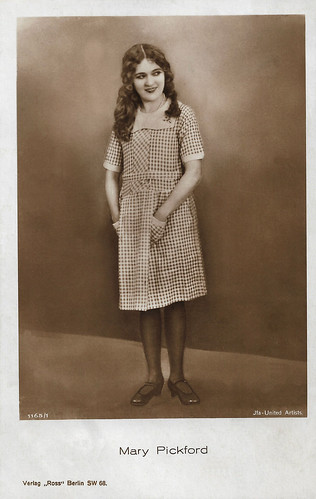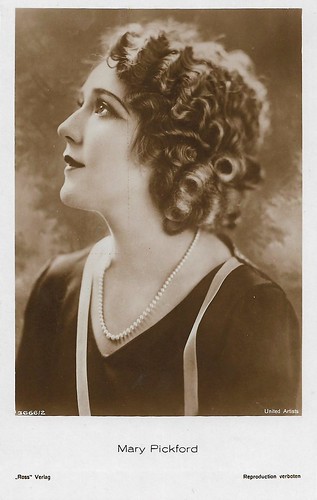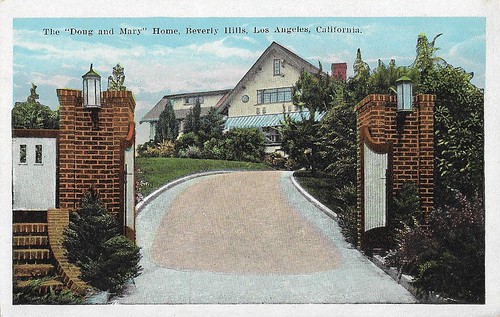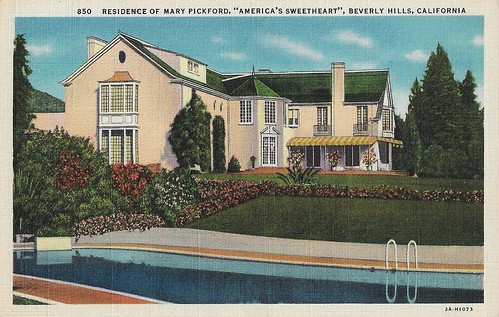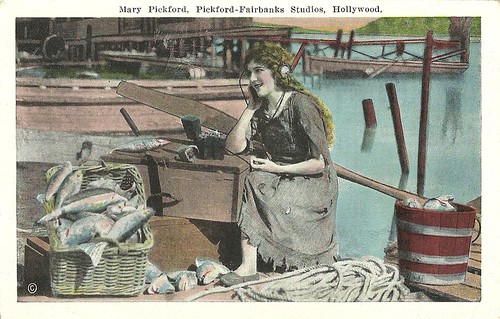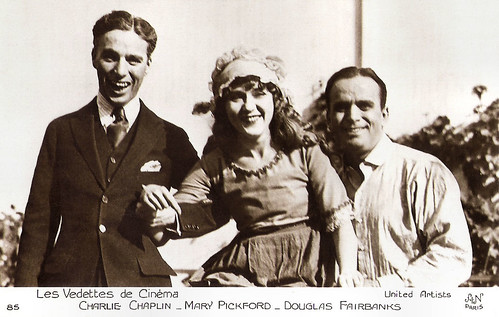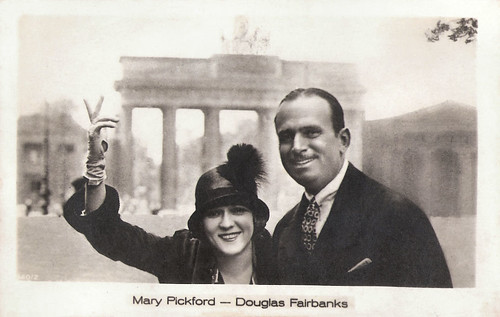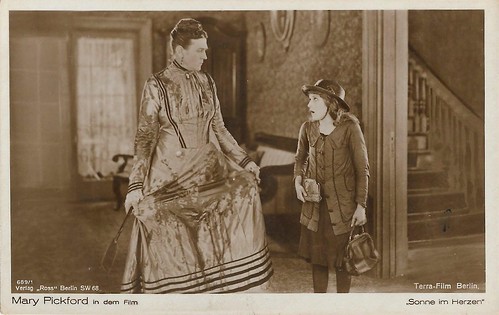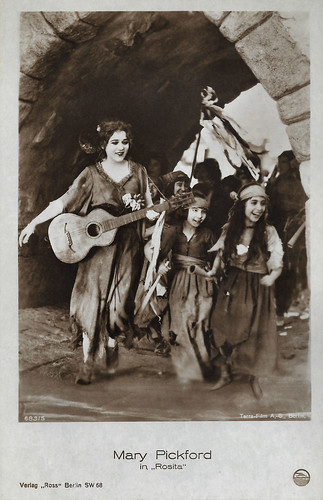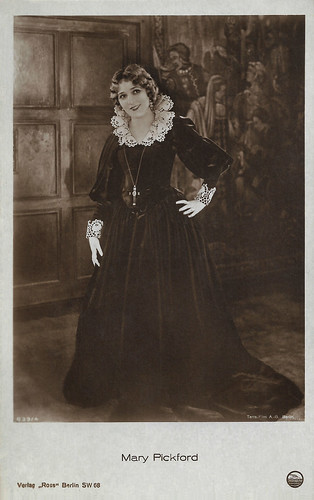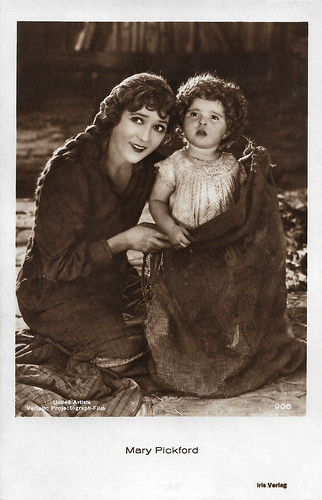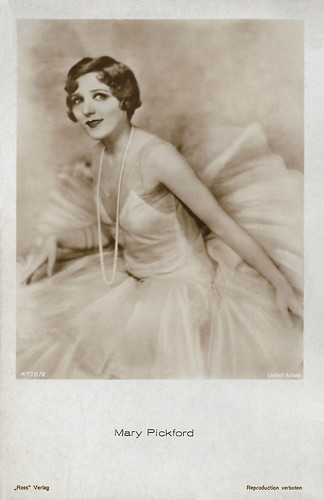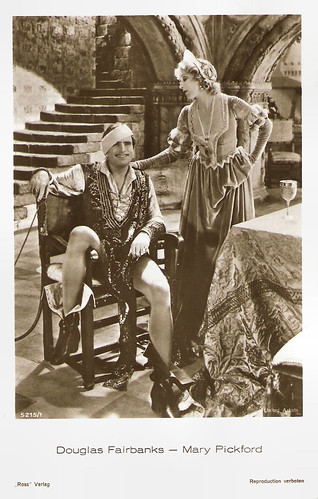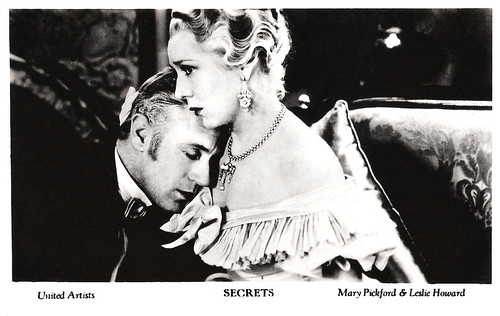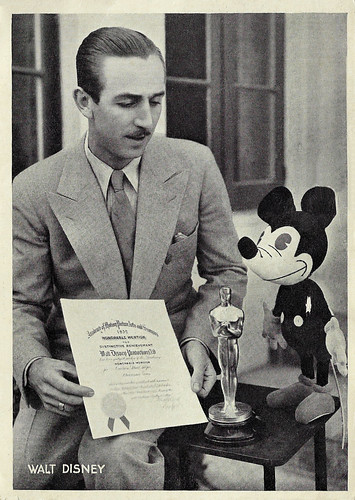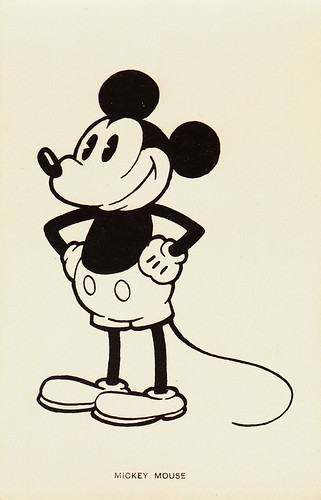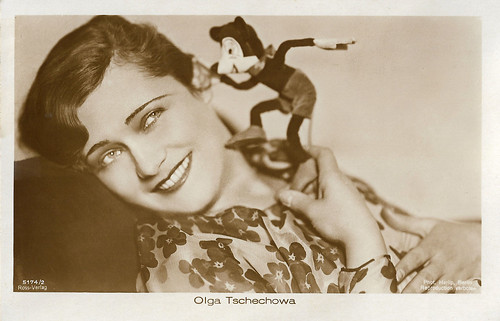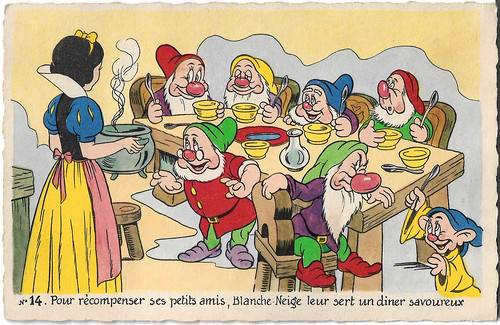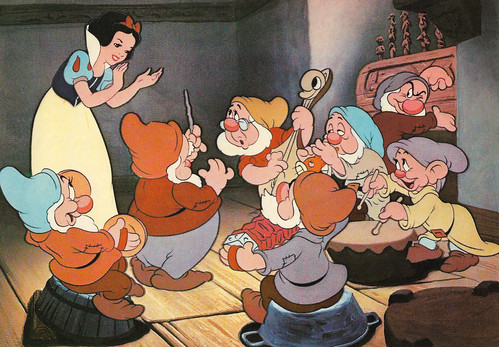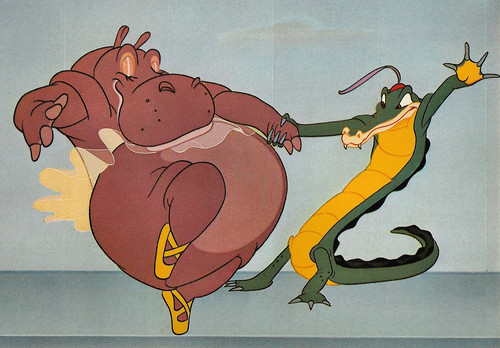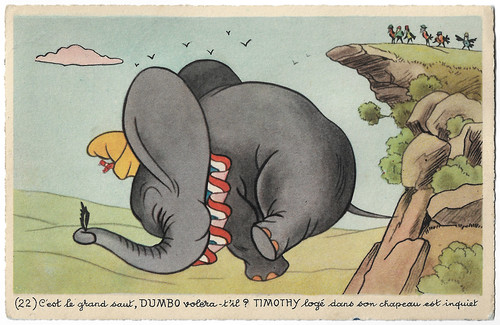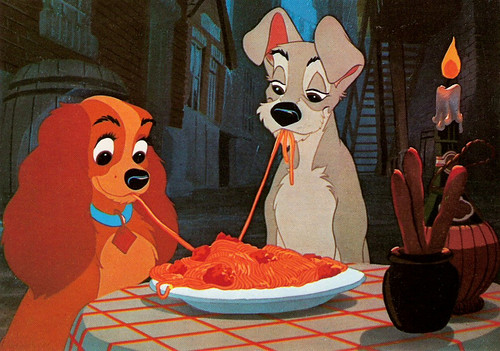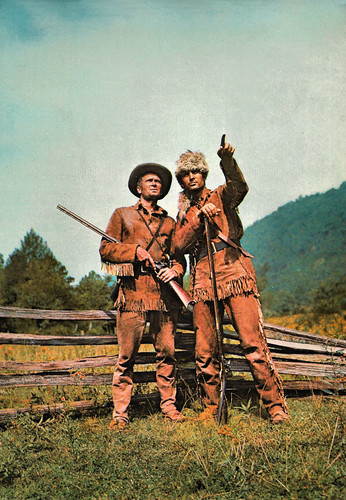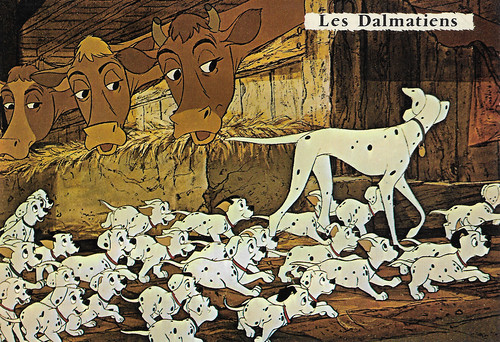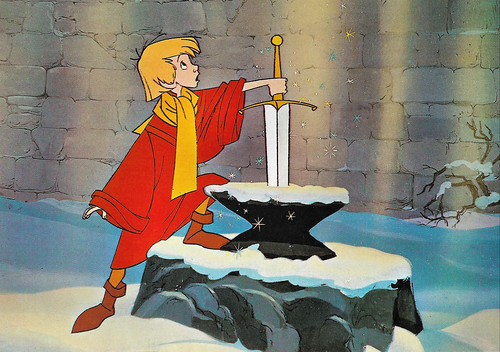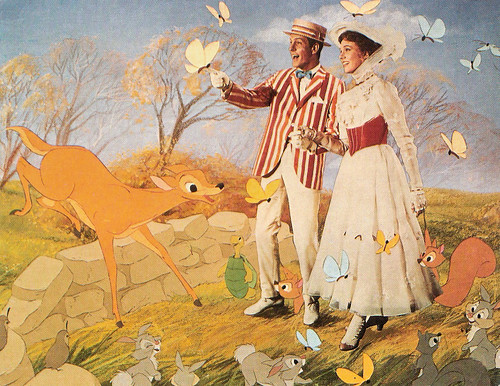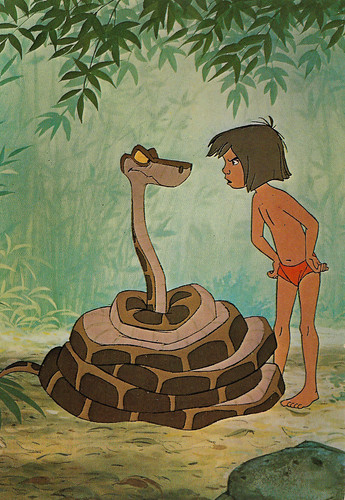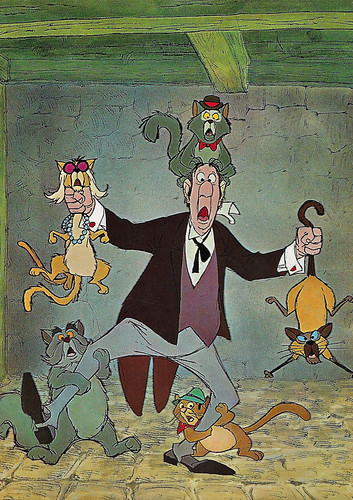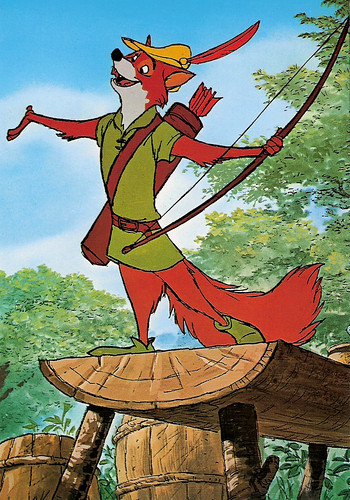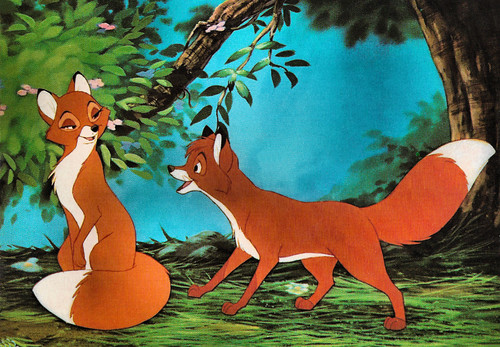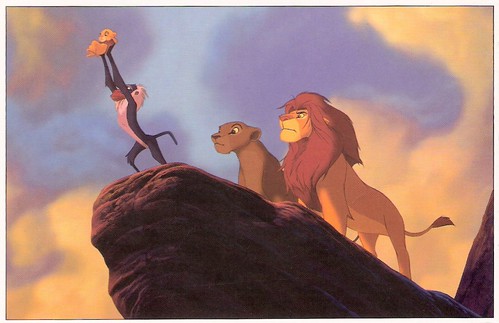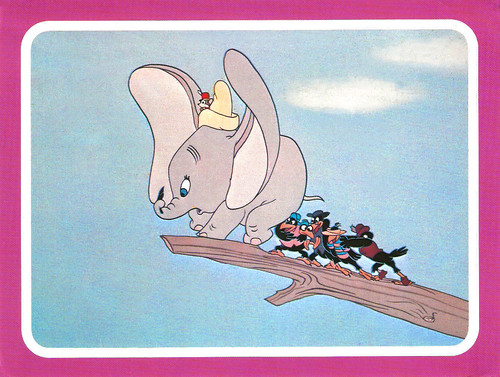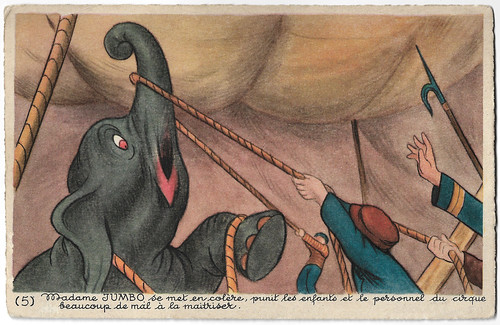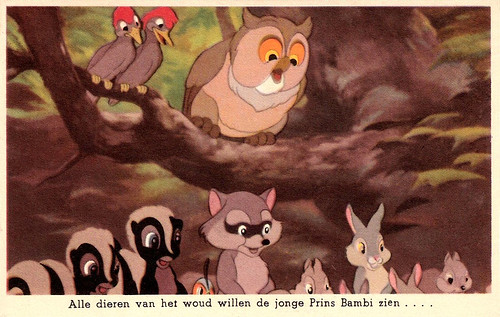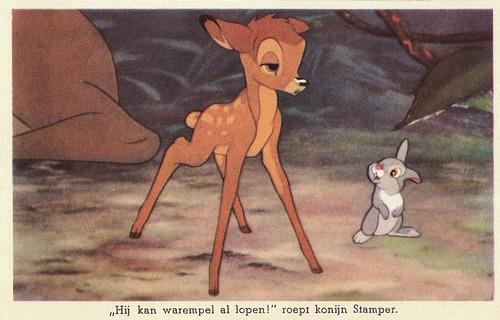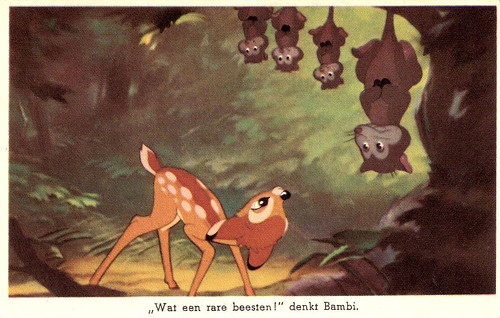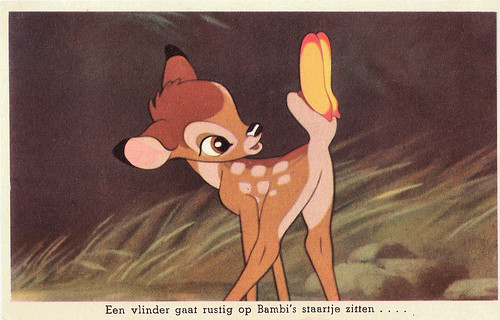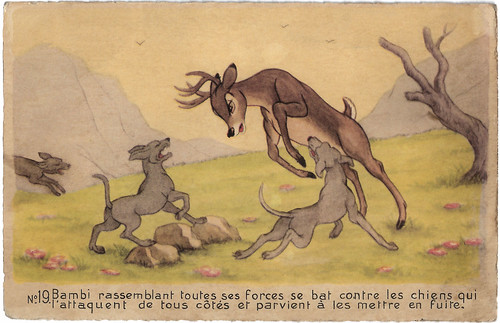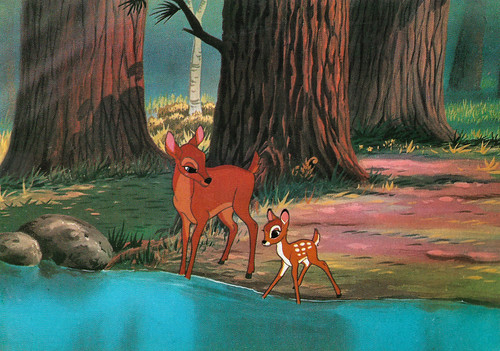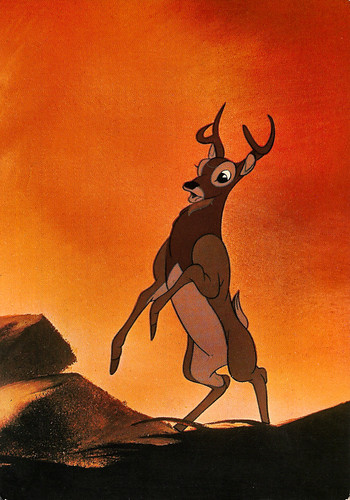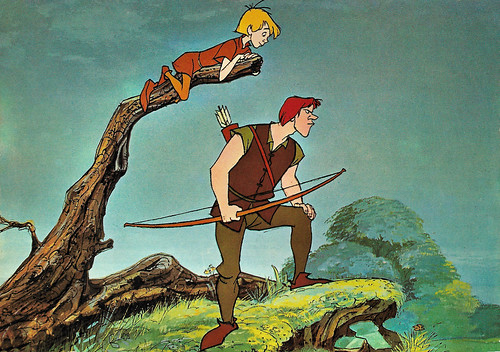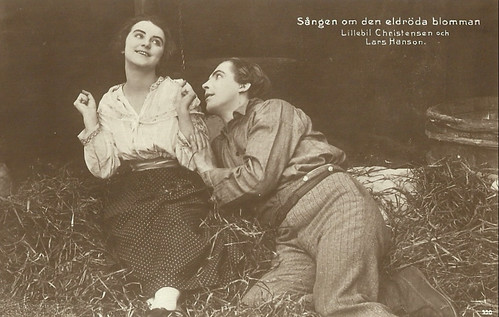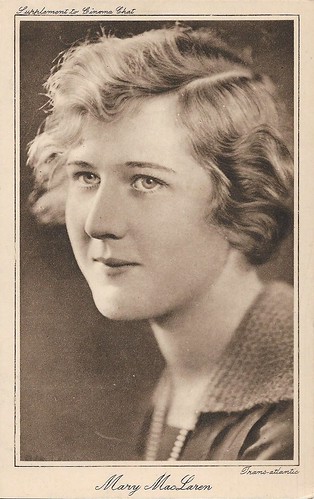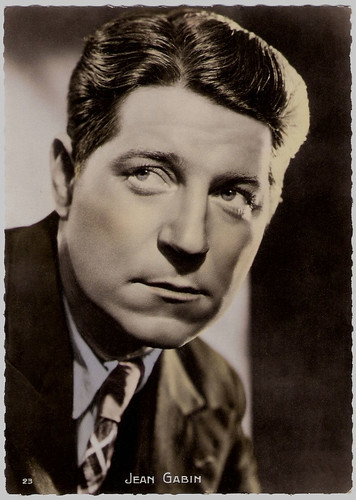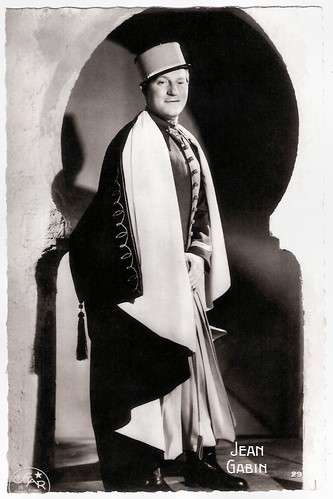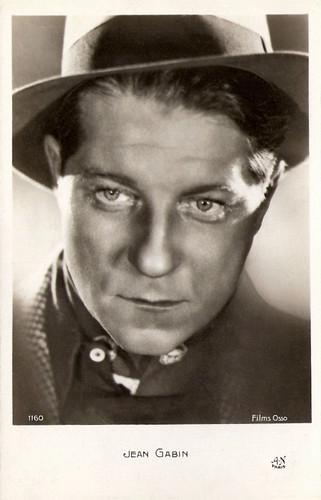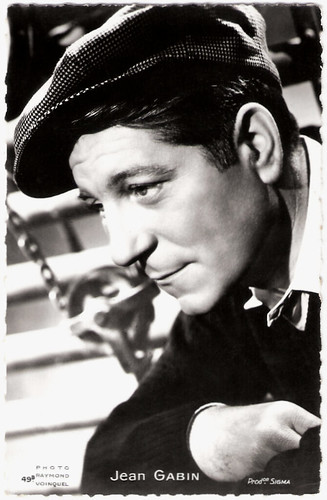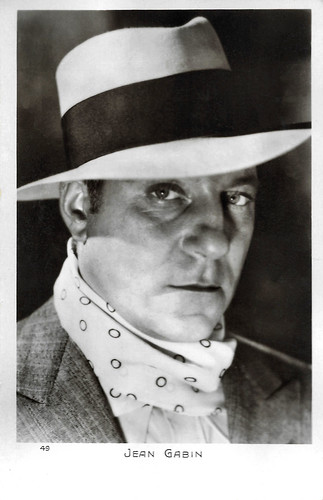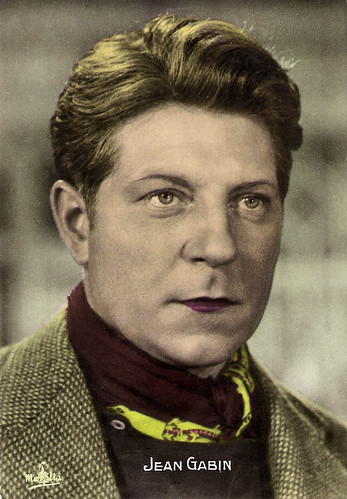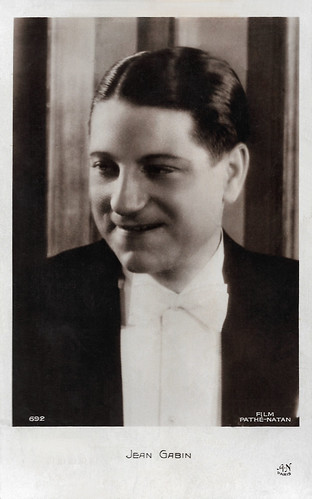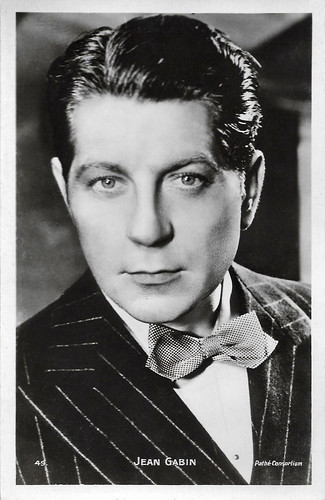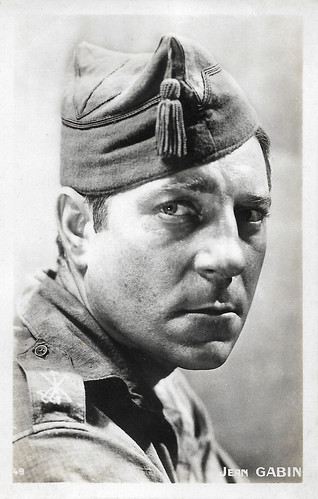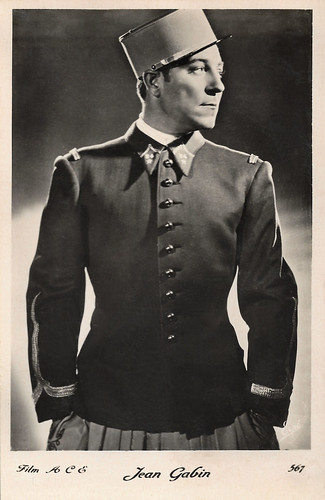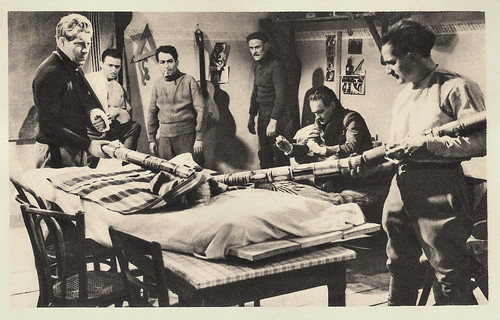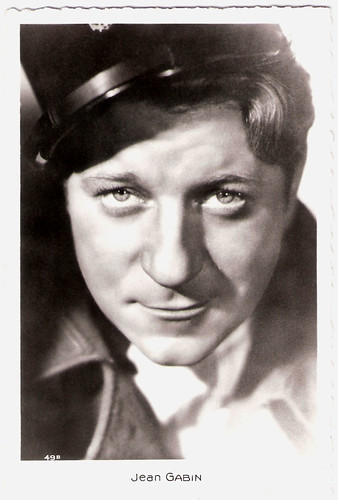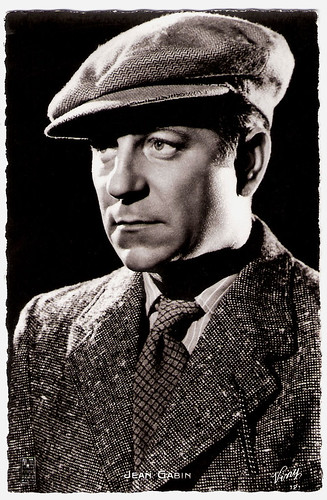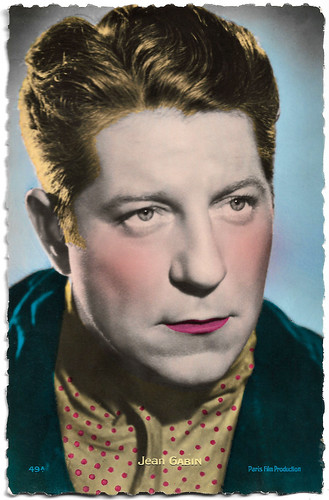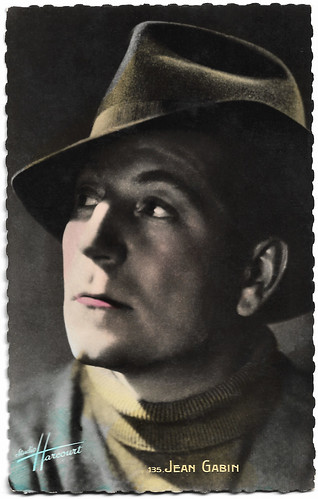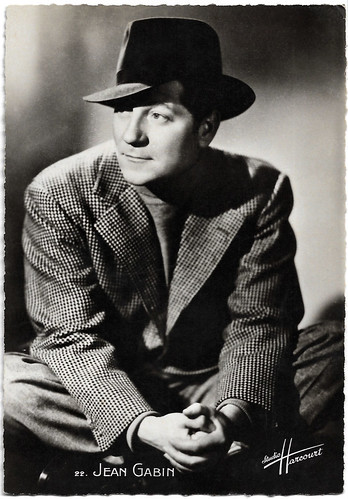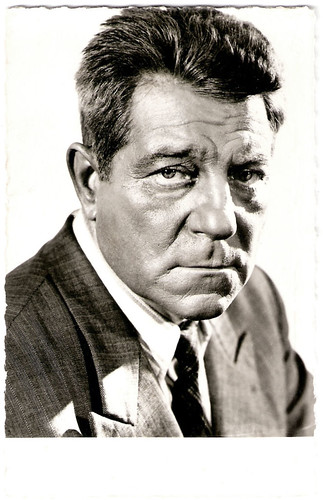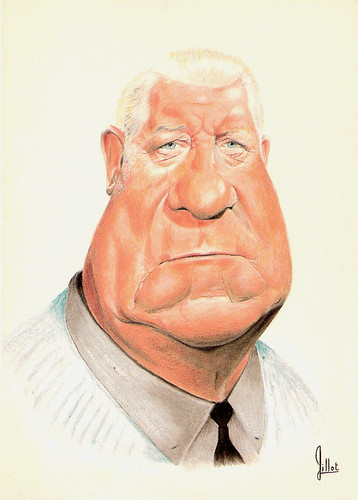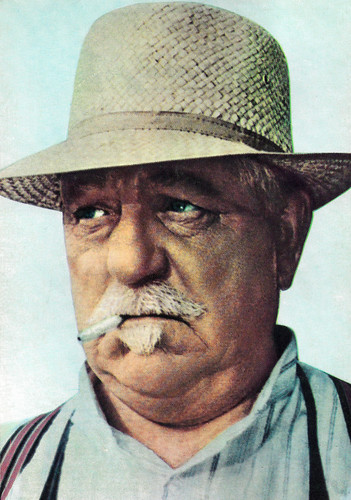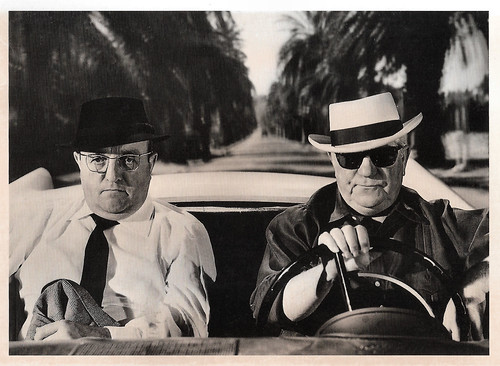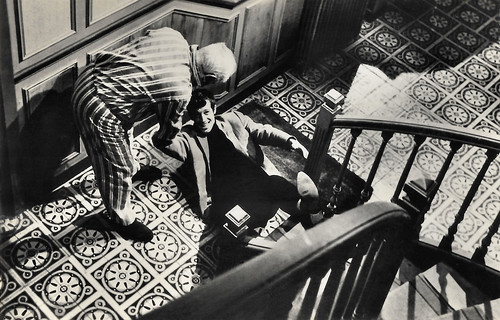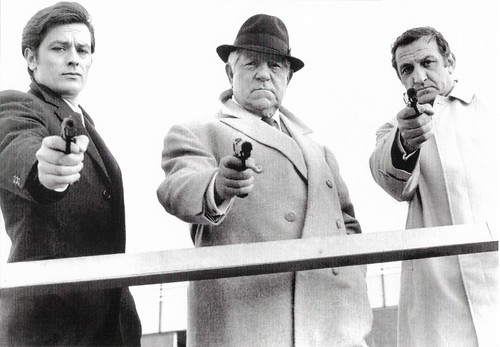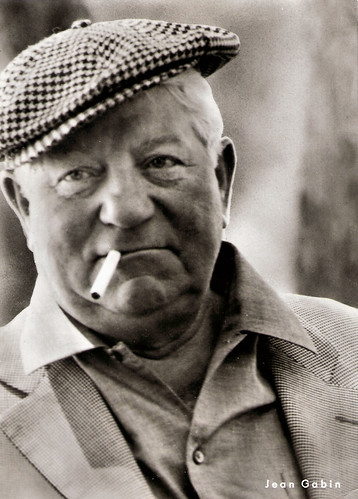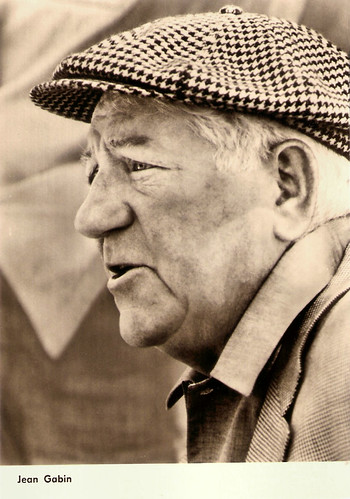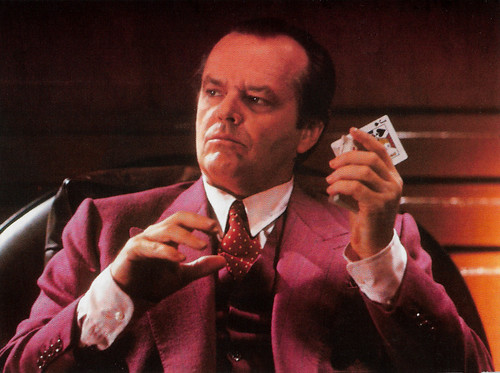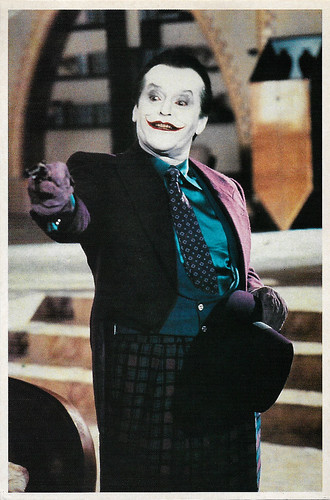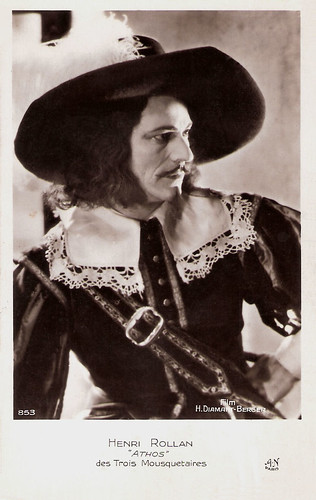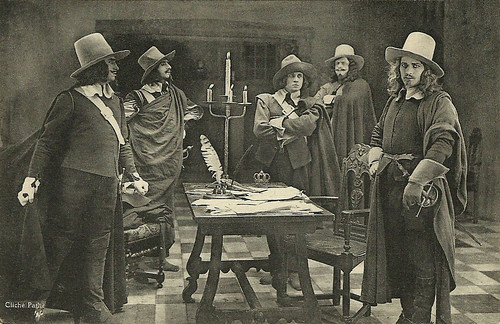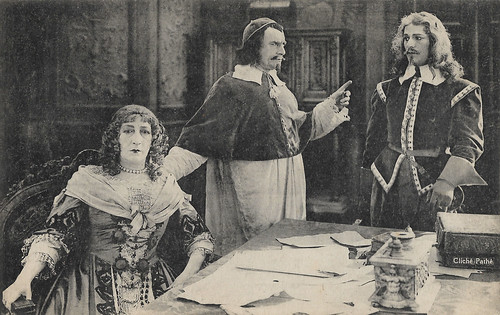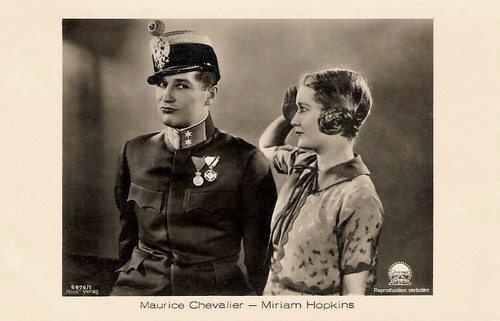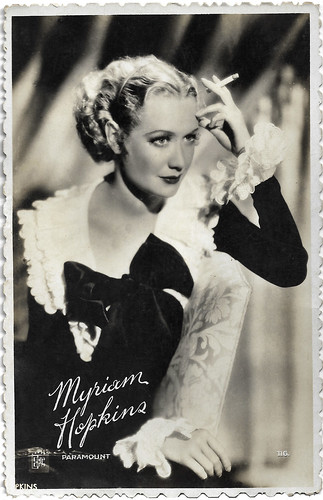Republic Pictures was an American film production-distribution corporation that operated from 1935 to 1967. The studio was best known for its Westerns, serials and B films emphasising mystery and action. Republic was also developed the careers of John Wayne, Gene Autry and Roy Rogers. It also financed and distributed several John Ford-directed films during the 1940s and early 1950s and one Shakespeare film, Macbeth (1948), directed by Orson Welles. Under the cigar-chomping Herbert J. Yates, Republic was considered a mini-major film studio.
![Roy Rogers]()
Dutch postcard. Photo: Republic Pictures.
American singer and cowboy actor Roy Rogers (1911–1998) was one of the most popular Western stars of his era. Known as the 'King of the Cowboys', he appeared in over 100 films.
![Roy Rogers, Dale Evans and Trigger]()
British postcard in the Picturegoer Series, London, no. W. 596. Photo: British Lion Republic. Roy Rogers, Dale Evans and Trigger.
![Sons of the pioneers]()
British postcard in the Picturegoer Series, London, no. W. 512. Photo: British Lion.
The Sons of the Pioneers are one of the United States' earliest Western singing groups. Known for their vocal performances, their musicianship, and their songwriting, they produced innovative recordings that have inspired many Western music performers and remained popular through the years. Since 1933, through many changes in membership, the Sons of the Pioneers have remained one of the longest-surviving country music vocal groups. Between 1935 and 1984, the Sons of the Pioneers appeared in 87 films.
In 1935, Republic was created by Herbert J. Yates (1880-1966), a long time investor in film and owner of the film processing laboratory Consolidated Film Industries. Yates had discreetly helped finance Darryl F. Zanuck's Twentieth Century Pictures in 1933. Zanuck's new studio would become a major customer of Yates' Consolidated Film Industries. Republic was initially formed by Yates' acquisition of six smaller independent studios along Gower Gulch, a section of Gower Street in Hollywood, also called 'Poverty Row'.
In the depths of the Great Depression, Yates' laboratory was no longer servicing the major studios, which had developed their own in-house laboratories for purposes of both economy and control, while the small, independent producers were going under in the face of Depression-born increased competition from the majors combined with the general impact of the depressed economy.
Yates thus decided to create a studio of his own to insure Consolidated's stability. Six surviving small companies (Monogram Pictures, Mascot Pictures, Liberty Pictures, Majestic Pictures, Chesterfield Pictures and Invincible Pictures) were all in debt to his lab. He prevailed upon these studios to merge under his leadership or else face foreclosure on their outstanding lab bills. Yates' new company, Republic Pictures Corporation, was presented to their producer-owners as a collaborative enterprise focused on low-budget product.
The largest of Republic's components was Monogram Pictures, run by producers Trem Carr and W. Ray Johnston, which specialised in B films and operated a nationwide distribution system. The most technologically advanced of the studios that now comprised Republic was Nat Levine's Mascot Pictures Corporation, which had been making serials almost exclusively since the mid-1920s and had a first-class production facility, the former Mack Sennett-Keystone lot in Studio City. Mascot also had just discovered Gene Autry and signed him to a contract as a singing cowboy star.
Larry Darmour's Majestic Pictures had developed an exhibitor following with big-name stars and rented sets giving his humble productions a polished look. Republic took its original Liberty Bell logo from M.H. Hoffman's Liberty Pictures as well as Hoffman's talents as a low-budget film producer. Chesterfield Pictures and Invincible Pictures, two sister companies under the same ownership, were skilled in producing low-budget melodramas and mysteries.
Acquiring and integrating these six companies enabled Republic to begin life with an experienced production staff, a company of veteran B-film supporting players and at least one very promising star, a complete distribution system and a functioning and modern studio. In exchange for merging, the principals were promised independence in their productions under the Republic aegis, and higher budgets with which to improve the quality of the films.
One of the first films Republic released successfully was the Western Westward Ho (Robert N. Bradbury, 1935) starring John Wayne and Sheila Bromley. Another box office hit was the Western Tumbling Tumbleweeds (Joseph Kane, 1935) starring Gene Autry, Smiley Burnette, and George ‘Gabby’ Hayes. Written by Ford Beebe, the film is about a cowboy who returns home after a five-year absence to find his father murdered and his boyhood pal accused of the dastardly deed. Tumbling Tumbleweeds features several songs including the classic 'Tumbling Tumbleweeds'.
![Roy Rogers]()
Dutch postcard, no. KF 34. Photo: Republic Pictures. Roy Rogers.
![George 'Gabby' Hayes]()
Dutch postcard, no. KF 50. Photo: Republic Pictures.
American character actor George 'Gabby' Hayes (1885-1969) was one of the colourful sidekicks to the leading men in the Hollywood Westerns of the 1930s and 1940s. His grizzled codger was so popular that Hayes landed repeatedly on the annual list of Top Ten Western Box-office Stars.
![Gene Autry]()
Dutch postcard, no. KF 31. Photo: Republic Pictures.
Gene Autry (1907-1998) was an American singer, and actor who gained fame as a singing cowboy in a crooning style on radio, in films, and on television for more than three decades beginning in the early 1930s. From 1934 to 1953, Autry appeared in 93 films, and between 1950 and 1956 hosted The Gene Autry Show television series.
![Vera Ralston]()
Belgian postcard by Nieuwe Merksemsche Chocolaterie S.P.R.L., Merksem (Anvers). Photo: Republic.
After achieving modest fame as an ice skater in her native Czechoslovakia, Vera Hruba (1923-2003) was brought to America by Republic Pictures head Herbert J. Yates, who hoped to turn her into the next Sonja Henie. After featuring her in two Ice Capades films, he added Ralston' to her name and tried to pass her off as a leading lady.
After he had learned the basics of film production and distribution from his partners, Herbert Yates began asserting more and more authority over their film departments, and dissension arose in the ranks. Trem Carr and W. Ray Johnston constantly clashed with Yates, who they felt was a tyrannical Hollywood interloper. They left and reactivated Monogram Pictures in 1937. Larry Darmour resumed independent production for Columbia Pictures.
Nat Levine managed to largely remain out of the fray, and by using many of the same production techniques he had used at Mascot, the new studio's output came to resemble the best of Levine's Mascot product. Levine was later bought out by Yates. Republic could also boast of having the best special effects department (then called 'miniatures') in the industry, which was headed by former Mascot employees Howard Lydecker and his brother Theodore Lydecker. This was a factor that greatly contributed to the quality level of Republic's output. Republic was often contracted by the major studios to provide special effects and miniature work for them.
Meanwhile, Yates installed a staff of new, associate producers who were loyal to him. Freed of partners, Yates presided over what was now his film studio and acquiring senior production and management staff who served him as employees, not experienced peers with independent ideas and agendas. Republic also acquired Brunswick Records to record its singing cowboys Gene Autry and Roy Rogers and hired Cy Feuer as head of its music department.
In its early years Republic was itself sometimes labelled a ‘Poverty Row’ company, as its primary products were B films and serials. Republic, however, showed more interest in — and provided larger budgets to — these films than many of the larger studios were doing, and certainly more than other independents were able to. The heart of the company was its Westerns, and its many Western-film leads — among them John Wayne, Gene Autry, Rex Allen and Roy Rogers— became recognisable stars at Republic.
However, by the mid-1940s Yates was producing better-quality pictures, mounting big-budget fare like Sands of Iwo Jima (Allan Dwan, 1949) starring John Wayne, The Quiet Man (John Ford, 1952) with John Wayne and Maureen O'Hara, Johnny Guitar (Nicholas Ray, 1954) with Joan Crawford and Sterling Hayden, and The Maverick Queen (Joseph Kane, 1956) featuring Barbara Stanwyck. Another distinguishing aspect of the studio was Yates' avoidance of any controversial subject matter, adhering to the Breen Office, in contrast to the other studios which dodged the Production Code.
From the mid-1940s Republic films often featured Vera Hruba Ralston, a former ice-skater from Czechoslovakia who had won the heart of studio boss Yates, becoming the second Mrs. Yates in 1949. She was originally featured in musicals as Republic's answer to Sonja Henie, but Yates tried to build her up as a dramatic star, casting her in leading roles opposite important male stars. Yates billed her as 'the most beautiful woman in films', but her charms were lost on the cinema audiences and exhibitors complained that Republic was making too many Ralston pictures. Years later, John Wayne admitted that the reason he left Republic in 1952 was the threat of having to make another picture with Miss Ralston. Yates remained Ralston's biggest supporter, and she continued to appear in Republic features until its very last production.
![Mala Powers]()
British postcard in the Picturegoer series, London, no. D 298. Photo: Republic Pictures.
American actress Mala Powers (1931-2007) played the lovely Roxanne opposite José Ferrer in Cyrano de Bergerac (1950) and starred in other Hollywood films of the 1950s. She was a leading authority on the acting techniques of Russian-American theatre practitioner Michael Chekhov.
![Penny Edwards]()
British postcard in the Picturegoer Series, London, no. W. 936. Photo: Republic Pictures.
Vivacious blue-eyed blonde Penny Edwards (1928-1998) was an American actress who performed on stage, in films, and on television. She made about two dozen films, initially working at Warners and Universal in the 1940s. She was under a term players contract at Republic Pictures from May, 1950 through October, 1951. At Republic, Edwards did mostly Westerns - six with Roy Rogers and one each with Rex Allen and Allan Lane.
![Anna Lee]()
Dutch postcard, no. 3484. Photo: Republic Pictures.
Blue-eyed blonde Anna Lee (1913-2004) was a British-born American actress. She started her career in British films and earned the title 'Queen of the Quota Quickies'. In 1939, she moved to Hollywood with her husband, director Robert Stevenson. There she often worked with John Ford, and later became a TV star in the soap series General Hospital.
![John Wayne]()
British postcard in the Picturegoer series, London, no W 477. Photo: British Lion / Republic Pictures.
American actor John Wayne (1907-1979) was one of the most popular film stars of the 20th century. He received his first leading film role in The Big Trail (Raoul Walsh, 1930). Working with John Ford, he got his next big break in Stagecoach (1939). His career as an actor took another leap forward when he worked with director Howard Hawks in Red River (1948). Wayne won his first Academy Award in 1969. He starred in 142 films altogether and remains a popular American icon to this day.
![Gail Russell]()
German postcard by Kolibri-Verlag, Minden/Westf. Photo: Republic Pictures / Gloria Filmverleih.
American actress Gail Russell (1924-1961) was an incredible doe-eyed beauty who presented a screen image of great innocence and vulnerability. She is best known for the supernatural horror film The Uninvited (1944). During a promising career at Paramount, she became a victim of alcoholism. It ruined her career, appearance and marriage to Guy Madison. In 1961, she died from liver damage, only 36.
With production costs increasing, Herbert Yates organised Republic's output into four types of films: ‘Jubilee’, usually a Western shot in seven days for about $50,000; ‘Anniversary’, filmed in 14-15 days for $175,000-$200,000; ‘Deluxe’, major productions made with a budget of around $500,000; and ‘Premiere’, which were usually made by top-rank directors who did not usually work for Republic, such as John Ford, Fritz Lang and Frank Borzage, and which could have a budget of $1,000,000 or more. An example of a 'Premiere' was the Film Noir House by the River (Fritz Lang, 1950) starring Louis Hayward and Jane Wyatt.
Some of these ‘Deluxe’ films were from independent production companies that were picked up for release by Republic. Although Republic made most of its films in black and white, it occasionally produced a higher-budgeted film, such as The Red Pony (Lewis Milestone, 1949) with Myrna Loy and Robert Mitchum, and The Quiet Man (John Ford, 1952), in Technicolor.
During the late 1940s and 1950s Yates utilised a low-cost Cinecolor process called Trucolor in many of his films, including Johnny Guitar (Nicholas Ray, 1954), The Last Command (Frank Lloyd, 1955) with Sterling Hayden and Anna Maria Alberghetti, and Magic Fire (William Dieterle, 1956), starring Yvonne De Carlo and Carlos Thompson. In 1956 Republic came up with its own widescreen film process, Naturama, with The Maverick Queen (Joseph Kane, 1956) the first film made in that process.
Perhaps inspired by the success of American International Pictures catering to teenagers, Republic released several films in the late 1950s about juvenile delinquency such as The Wayward Girl (Lesley Selander, 1957) with Marcia Henderson, Juvenile Jungle (William Witney, 1958) and Young and Wild (William Witney, 1958) starring Gene Evans.
Republic was one of the first Hollywood studios to offer its film library to television. In 1951 Republic established a subsidiary, Hollywood Television Service, to sell screening rights in its vintage Westerns and action thrillers. Many of these films, especially the Westerns, were edited to fit in a one-hour television slot. Hollywood Television Service also produced television shows filmed in the same style as Republic's serials, such as The Adventures of Fu Manchu (Franklin Adreon, 1956). Also, in 1952 the Republic studio lot became the first home of MCA's series factory, Revue Productions.
While it appeared that Republic was well suited for television series production, it did not have the finances or vision to do so. Yet by the mid-1950s, thanks to its sale of old features and leasing of studio space to MCA, television was the prop supporting Republic. During this period the studio produced Commando Cody: Sky Marshal of the Universe (Harry Keller, Franklin Adreon, Fred C. Brannon, 1953). The 12-part serial was unsuccessful as a theatre release, but it was later sold to NBC for television distribution.
Talent agent MCA exerted influence at the studio, bringing in some high-paid clients for occasional features, and it was rumoured at various times that either MCA or deposed MGM head Louis B. Mayer would buy the studio outright. Republic produced The Pride of the Family (Bob Finkel, a.o., 1953-1954), a situation comedy on ABC starring Paul Hartman, Fay Wray and Natalie Wood. The following years, the studio produced Stories of the Century (William Witney, Franklin Andreon, 1954-1955), starring and narrated by Jim Davis. The syndicated series was the first Western to win an Emmy Award.
As the demand and market for films declined with the increasing popularity of television, Republic began to cut back on its films, slowing production from 40 features annually in the early 1950s to 18 in 1957. A tearful Yates informed shareholders at the 1958 annual meeting that feature film production was ending. The distribution offices were shut down the following year.
In 1959 Victor M. Carter, a Los Angeles businessman and turnaround specialist, acquired controlling interest in the floundering company, becoming its president. He turned Republic into a diversified business that included plastics and appliances in addition to its film and studio rentals and Consolidated Film Industries, renaming the company Republic Corporations. Having used the studio for series production for years, Republic began leasing its backlot to other firms, including CBS, in 1963. In 1967 Republic's studio was purchased outright by CBS. Republic sold its library of films to National Telefilm Associates (NTA).
In 1966, Herbert Yates died an extremely wealthy man and eventually left Vera Ralston a very rich widow. The Republic film library is now located at the UCLA Film and Television Archive.
![Ben Cooper]()
British postcard in the Picturegoer series, no D. 496. Photo: Republic Pictures.
Ben Cooper (1933) is a retired American actor of film and television, who won a Golden Boot Award in 2005 for his work in Westerns. The baby faced leading man appeared as well in Republic Westerns and in many TV Western series.
![Smiley Burnette]()
Dutch postcard. Photo: Republic Pictures.
American country music performer and actor Smiley Burnette (1911-1967) was known as Gene Autry's plump, comic sidekick 'Ole Frog' Milhouse in over 60 Westerns. His trademarks were his floppy black hat and his trick voice, imitating a deep, froglike croak. Smiley's career, beginning in 1934, spanned four decades.
![Monte Hale]()
Dutch postcard. Photo: Centrafilm / Republic Pictures.
Monte Hale (1919-2009) was an American B-Western film star and country musician. He was one of the last of the 'singing cowboys' of Republic Pictures.
![Lex Barker]()
Small German collectors card, no. 85. Photo: Republic.
After a Hollywood career as Tarzan and as Mr. Lana Turner, Lex Barker (1919-1973) moved to Europe. Here he worked with Federico Fellini and later became Old Shatterhand in the popular Karl May film series.
![Joe E. Brown]()
Small collectors card, no. C 28. Photo: Republic Pictures.
American comedian Joe E. Brown (1891-1973) is dearly remembered for his portrayal as Osgood Fielding III in Billy Wilder's Some Like It Hot (1959), in which he utters the famous punchline "Well, nobody's perfect". With his amiable screen persona, comic timing, and enormous elastic-mouth smile, Brown was one of the most popular American comedians in the 1930s and 1940s, with successful films like A Midsummer Night's Dream (1935), Earthworm Tractors (1936) and Alibi Ike (1935).
Sources: Wikipedia and IMDb.
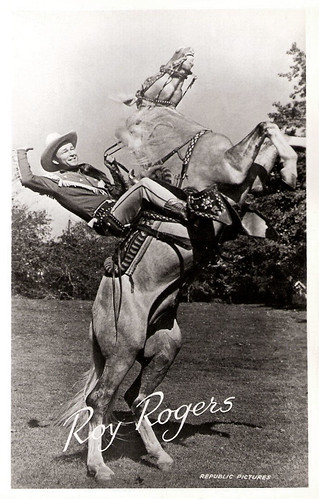
Dutch postcard. Photo: Republic Pictures.
American singer and cowboy actor Roy Rogers (1911–1998) was one of the most popular Western stars of his era. Known as the 'King of the Cowboys', he appeared in over 100 films.
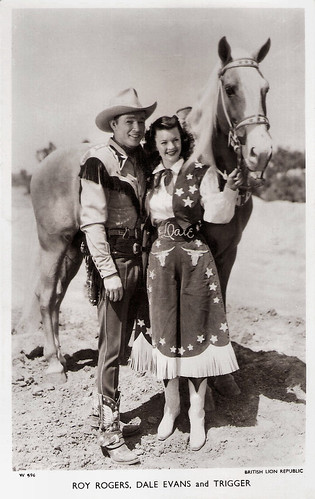
British postcard in the Picturegoer Series, London, no. W. 596. Photo: British Lion Republic. Roy Rogers, Dale Evans and Trigger.

British postcard in the Picturegoer Series, London, no. W. 512. Photo: British Lion.
The Sons of the Pioneers are one of the United States' earliest Western singing groups. Known for their vocal performances, their musicianship, and their songwriting, they produced innovative recordings that have inspired many Western music performers and remained popular through the years. Since 1933, through many changes in membership, the Sons of the Pioneers have remained one of the longest-surviving country music vocal groups. Between 1935 and 1984, the Sons of the Pioneers appeared in 87 films.
A studio merger on Poverty Row
In 1935, Republic was created by Herbert J. Yates (1880-1966), a long time investor in film and owner of the film processing laboratory Consolidated Film Industries. Yates had discreetly helped finance Darryl F. Zanuck's Twentieth Century Pictures in 1933. Zanuck's new studio would become a major customer of Yates' Consolidated Film Industries. Republic was initially formed by Yates' acquisition of six smaller independent studios along Gower Gulch, a section of Gower Street in Hollywood, also called 'Poverty Row'.
In the depths of the Great Depression, Yates' laboratory was no longer servicing the major studios, which had developed their own in-house laboratories for purposes of both economy and control, while the small, independent producers were going under in the face of Depression-born increased competition from the majors combined with the general impact of the depressed economy.
Yates thus decided to create a studio of his own to insure Consolidated's stability. Six surviving small companies (Monogram Pictures, Mascot Pictures, Liberty Pictures, Majestic Pictures, Chesterfield Pictures and Invincible Pictures) were all in debt to his lab. He prevailed upon these studios to merge under his leadership or else face foreclosure on their outstanding lab bills. Yates' new company, Republic Pictures Corporation, was presented to their producer-owners as a collaborative enterprise focused on low-budget product.
The largest of Republic's components was Monogram Pictures, run by producers Trem Carr and W. Ray Johnston, which specialised in B films and operated a nationwide distribution system. The most technologically advanced of the studios that now comprised Republic was Nat Levine's Mascot Pictures Corporation, which had been making serials almost exclusively since the mid-1920s and had a first-class production facility, the former Mack Sennett-Keystone lot in Studio City. Mascot also had just discovered Gene Autry and signed him to a contract as a singing cowboy star.
Larry Darmour's Majestic Pictures had developed an exhibitor following with big-name stars and rented sets giving his humble productions a polished look. Republic took its original Liberty Bell logo from M.H. Hoffman's Liberty Pictures as well as Hoffman's talents as a low-budget film producer. Chesterfield Pictures and Invincible Pictures, two sister companies under the same ownership, were skilled in producing low-budget melodramas and mysteries.
Acquiring and integrating these six companies enabled Republic to begin life with an experienced production staff, a company of veteran B-film supporting players and at least one very promising star, a complete distribution system and a functioning and modern studio. In exchange for merging, the principals were promised independence in their productions under the Republic aegis, and higher budgets with which to improve the quality of the films.
One of the first films Republic released successfully was the Western Westward Ho (Robert N. Bradbury, 1935) starring John Wayne and Sheila Bromley. Another box office hit was the Western Tumbling Tumbleweeds (Joseph Kane, 1935) starring Gene Autry, Smiley Burnette, and George ‘Gabby’ Hayes. Written by Ford Beebe, the film is about a cowboy who returns home after a five-year absence to find his father murdered and his boyhood pal accused of the dastardly deed. Tumbling Tumbleweeds features several songs including the classic 'Tumbling Tumbleweeds'.

Dutch postcard, no. KF 34. Photo: Republic Pictures. Roy Rogers.

Dutch postcard, no. KF 50. Photo: Republic Pictures.
American character actor George 'Gabby' Hayes (1885-1969) was one of the colourful sidekicks to the leading men in the Hollywood Westerns of the 1930s and 1940s. His grizzled codger was so popular that Hayes landed repeatedly on the annual list of Top Ten Western Box-office Stars.
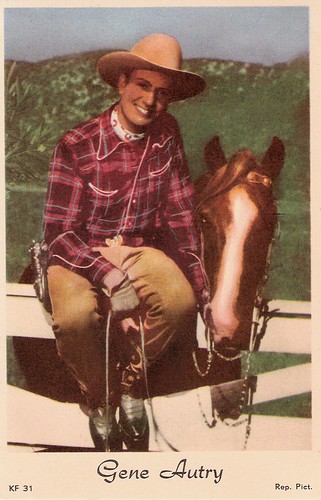
Dutch postcard, no. KF 31. Photo: Republic Pictures.
Gene Autry (1907-1998) was an American singer, and actor who gained fame as a singing cowboy in a crooning style on radio, in films, and on television for more than three decades beginning in the early 1930s. From 1934 to 1953, Autry appeared in 93 films, and between 1950 and 1956 hosted The Gene Autry Show television series.
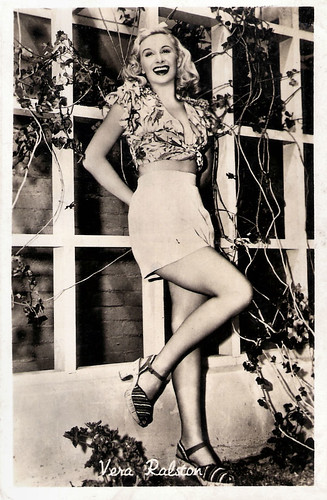
Belgian postcard by Nieuwe Merksemsche Chocolaterie S.P.R.L., Merksem (Anvers). Photo: Republic.
After achieving modest fame as an ice skater in her native Czechoslovakia, Vera Hruba (1923-2003) was brought to America by Republic Pictures head Herbert J. Yates, who hoped to turn her into the next Sonja Henie. After featuring her in two Ice Capades films, he added Ralston' to her name and tried to pass her off as a leading lady.
A Rise of Dissension in the Ranks
After he had learned the basics of film production and distribution from his partners, Herbert Yates began asserting more and more authority over their film departments, and dissension arose in the ranks. Trem Carr and W. Ray Johnston constantly clashed with Yates, who they felt was a tyrannical Hollywood interloper. They left and reactivated Monogram Pictures in 1937. Larry Darmour resumed independent production for Columbia Pictures.
Nat Levine managed to largely remain out of the fray, and by using many of the same production techniques he had used at Mascot, the new studio's output came to resemble the best of Levine's Mascot product. Levine was later bought out by Yates. Republic could also boast of having the best special effects department (then called 'miniatures') in the industry, which was headed by former Mascot employees Howard Lydecker and his brother Theodore Lydecker. This was a factor that greatly contributed to the quality level of Republic's output. Republic was often contracted by the major studios to provide special effects and miniature work for them.
Meanwhile, Yates installed a staff of new, associate producers who were loyal to him. Freed of partners, Yates presided over what was now his film studio and acquiring senior production and management staff who served him as employees, not experienced peers with independent ideas and agendas. Republic also acquired Brunswick Records to record its singing cowboys Gene Autry and Roy Rogers and hired Cy Feuer as head of its music department.
In its early years Republic was itself sometimes labelled a ‘Poverty Row’ company, as its primary products were B films and serials. Republic, however, showed more interest in — and provided larger budgets to — these films than many of the larger studios were doing, and certainly more than other independents were able to. The heart of the company was its Westerns, and its many Western-film leads — among them John Wayne, Gene Autry, Rex Allen and Roy Rogers— became recognisable stars at Republic.
However, by the mid-1940s Yates was producing better-quality pictures, mounting big-budget fare like Sands of Iwo Jima (Allan Dwan, 1949) starring John Wayne, The Quiet Man (John Ford, 1952) with John Wayne and Maureen O'Hara, Johnny Guitar (Nicholas Ray, 1954) with Joan Crawford and Sterling Hayden, and The Maverick Queen (Joseph Kane, 1956) featuring Barbara Stanwyck. Another distinguishing aspect of the studio was Yates' avoidance of any controversial subject matter, adhering to the Breen Office, in contrast to the other studios which dodged the Production Code.
From the mid-1940s Republic films often featured Vera Hruba Ralston, a former ice-skater from Czechoslovakia who had won the heart of studio boss Yates, becoming the second Mrs. Yates in 1949. She was originally featured in musicals as Republic's answer to Sonja Henie, but Yates tried to build her up as a dramatic star, casting her in leading roles opposite important male stars. Yates billed her as 'the most beautiful woman in films', but her charms were lost on the cinema audiences and exhibitors complained that Republic was making too many Ralston pictures. Years later, John Wayne admitted that the reason he left Republic in 1952 was the threat of having to make another picture with Miss Ralston. Yates remained Ralston's biggest supporter, and she continued to appear in Republic features until its very last production.

British postcard in the Picturegoer series, London, no. D 298. Photo: Republic Pictures.
American actress Mala Powers (1931-2007) played the lovely Roxanne opposite José Ferrer in Cyrano de Bergerac (1950) and starred in other Hollywood films of the 1950s. She was a leading authority on the acting techniques of Russian-American theatre practitioner Michael Chekhov.
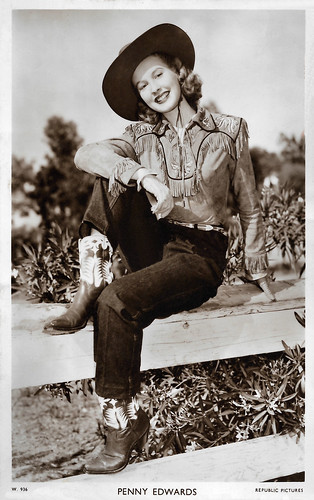
British postcard in the Picturegoer Series, London, no. W. 936. Photo: Republic Pictures.
Vivacious blue-eyed blonde Penny Edwards (1928-1998) was an American actress who performed on stage, in films, and on television. She made about two dozen films, initially working at Warners and Universal in the 1940s. She was under a term players contract at Republic Pictures from May, 1950 through October, 1951. At Republic, Edwards did mostly Westerns - six with Roy Rogers and one each with Rex Allen and Allan Lane.
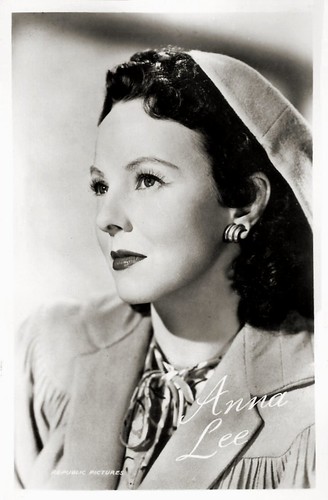
Dutch postcard, no. 3484. Photo: Republic Pictures.
Blue-eyed blonde Anna Lee (1913-2004) was a British-born American actress. She started her career in British films and earned the title 'Queen of the Quota Quickies'. In 1939, she moved to Hollywood with her husband, director Robert Stevenson. There she often worked with John Ford, and later became a TV star in the soap series General Hospital.

British postcard in the Picturegoer series, London, no W 477. Photo: British Lion / Republic Pictures.
American actor John Wayne (1907-1979) was one of the most popular film stars of the 20th century. He received his first leading film role in The Big Trail (Raoul Walsh, 1930). Working with John Ford, he got his next big break in Stagecoach (1939). His career as an actor took another leap forward when he worked with director Howard Hawks in Red River (1948). Wayne won his first Academy Award in 1969. He starred in 142 films altogether and remains a popular American icon to this day.

German postcard by Kolibri-Verlag, Minden/Westf. Photo: Republic Pictures / Gloria Filmverleih.
American actress Gail Russell (1924-1961) was an incredible doe-eyed beauty who presented a screen image of great innocence and vulnerability. She is best known for the supernatural horror film The Uninvited (1944). During a promising career at Paramount, she became a victim of alcoholism. It ruined her career, appearance and marriage to Guy Madison. In 1961, she died from liver damage, only 36.
Television as the prop supporting Republic
With production costs increasing, Herbert Yates organised Republic's output into four types of films: ‘Jubilee’, usually a Western shot in seven days for about $50,000; ‘Anniversary’, filmed in 14-15 days for $175,000-$200,000; ‘Deluxe’, major productions made with a budget of around $500,000; and ‘Premiere’, which were usually made by top-rank directors who did not usually work for Republic, such as John Ford, Fritz Lang and Frank Borzage, and which could have a budget of $1,000,000 or more. An example of a 'Premiere' was the Film Noir House by the River (Fritz Lang, 1950) starring Louis Hayward and Jane Wyatt.
Some of these ‘Deluxe’ films were from independent production companies that were picked up for release by Republic. Although Republic made most of its films in black and white, it occasionally produced a higher-budgeted film, such as The Red Pony (Lewis Milestone, 1949) with Myrna Loy and Robert Mitchum, and The Quiet Man (John Ford, 1952), in Technicolor.
During the late 1940s and 1950s Yates utilised a low-cost Cinecolor process called Trucolor in many of his films, including Johnny Guitar (Nicholas Ray, 1954), The Last Command (Frank Lloyd, 1955) with Sterling Hayden and Anna Maria Alberghetti, and Magic Fire (William Dieterle, 1956), starring Yvonne De Carlo and Carlos Thompson. In 1956 Republic came up with its own widescreen film process, Naturama, with The Maverick Queen (Joseph Kane, 1956) the first film made in that process.
Perhaps inspired by the success of American International Pictures catering to teenagers, Republic released several films in the late 1950s about juvenile delinquency such as The Wayward Girl (Lesley Selander, 1957) with Marcia Henderson, Juvenile Jungle (William Witney, 1958) and Young and Wild (William Witney, 1958) starring Gene Evans.
Republic was one of the first Hollywood studios to offer its film library to television. In 1951 Republic established a subsidiary, Hollywood Television Service, to sell screening rights in its vintage Westerns and action thrillers. Many of these films, especially the Westerns, were edited to fit in a one-hour television slot. Hollywood Television Service also produced television shows filmed in the same style as Republic's serials, such as The Adventures of Fu Manchu (Franklin Adreon, 1956). Also, in 1952 the Republic studio lot became the first home of MCA's series factory, Revue Productions.
While it appeared that Republic was well suited for television series production, it did not have the finances or vision to do so. Yet by the mid-1950s, thanks to its sale of old features and leasing of studio space to MCA, television was the prop supporting Republic. During this period the studio produced Commando Cody: Sky Marshal of the Universe (Harry Keller, Franklin Adreon, Fred C. Brannon, 1953). The 12-part serial was unsuccessful as a theatre release, but it was later sold to NBC for television distribution.
Talent agent MCA exerted influence at the studio, bringing in some high-paid clients for occasional features, and it was rumoured at various times that either MCA or deposed MGM head Louis B. Mayer would buy the studio outright. Republic produced The Pride of the Family (Bob Finkel, a.o., 1953-1954), a situation comedy on ABC starring Paul Hartman, Fay Wray and Natalie Wood. The following years, the studio produced Stories of the Century (William Witney, Franklin Andreon, 1954-1955), starring and narrated by Jim Davis. The syndicated series was the first Western to win an Emmy Award.
As the demand and market for films declined with the increasing popularity of television, Republic began to cut back on its films, slowing production from 40 features annually in the early 1950s to 18 in 1957. A tearful Yates informed shareholders at the 1958 annual meeting that feature film production was ending. The distribution offices were shut down the following year.
In 1959 Victor M. Carter, a Los Angeles businessman and turnaround specialist, acquired controlling interest in the floundering company, becoming its president. He turned Republic into a diversified business that included plastics and appliances in addition to its film and studio rentals and Consolidated Film Industries, renaming the company Republic Corporations. Having used the studio for series production for years, Republic began leasing its backlot to other firms, including CBS, in 1963. In 1967 Republic's studio was purchased outright by CBS. Republic sold its library of films to National Telefilm Associates (NTA).
In 1966, Herbert Yates died an extremely wealthy man and eventually left Vera Ralston a very rich widow. The Republic film library is now located at the UCLA Film and Television Archive.

British postcard in the Picturegoer series, no D. 496. Photo: Republic Pictures.
Ben Cooper (1933) is a retired American actor of film and television, who won a Golden Boot Award in 2005 for his work in Westerns. The baby faced leading man appeared as well in Republic Westerns and in many TV Western series.
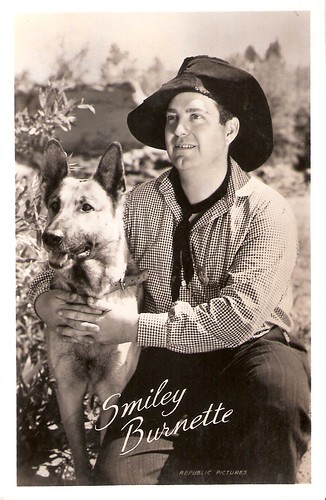
Dutch postcard. Photo: Republic Pictures.
American country music performer and actor Smiley Burnette (1911-1967) was known as Gene Autry's plump, comic sidekick 'Ole Frog' Milhouse in over 60 Westerns. His trademarks were his floppy black hat and his trick voice, imitating a deep, froglike croak. Smiley's career, beginning in 1934, spanned four decades.

Dutch postcard. Photo: Centrafilm / Republic Pictures.
Monte Hale (1919-2009) was an American B-Western film star and country musician. He was one of the last of the 'singing cowboys' of Republic Pictures.

Small German collectors card, no. 85. Photo: Republic.
After a Hollywood career as Tarzan and as Mr. Lana Turner, Lex Barker (1919-1973) moved to Europe. Here he worked with Federico Fellini and later became Old Shatterhand in the popular Karl May film series.

Small collectors card, no. C 28. Photo: Republic Pictures.
American comedian Joe E. Brown (1891-1973) is dearly remembered for his portrayal as Osgood Fielding III in Billy Wilder's Some Like It Hot (1959), in which he utters the famous punchline "Well, nobody's perfect". With his amiable screen persona, comic timing, and enormous elastic-mouth smile, Brown was one of the most popular American comedians in the 1930s and 1940s, with successful films like A Midsummer Night's Dream (1935), Earthworm Tractors (1936) and Alibi Ike (1935).
Sources: Wikipedia and IMDb.




















